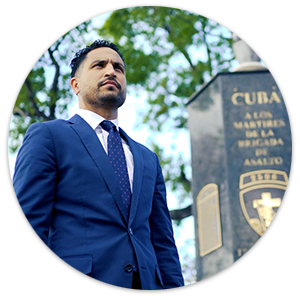When someone is involved in an accident, whether it is a car crash, a slip and fall, or some other type of incident, medical treatment is often necessary. But beyond just feeling better, the documentation of this medical treatment becomes a crucial piece in any legal case. This documentation includes things like medical records, bills, treatment plans, and even doctor’s notes. Each document serves as proof that injuries were real, that treatment was necessary, and that certain costs were incurred because of the incident. Without these records, proving the extent of an injury can be much harder, and it may become difficult to get fair compensation for pain, suffering, and medical costs. In a legal case, the role of medical documentation is fundamental to showing what happened and helping victims get the support they deserve. At, The Guzman Firm, PLLC , we are here to guide you through the legal process and help you navigate the complexities of your case.
Richard Guzman’s expertise focuses on one primary objective: to offer tactical legal analysis, guidance, and result-driven solutions. The Guzman Firm is dedicated to providing you with the knowledgeable and competent counsel you deserve.
Attorney Richard Guzman
Medical Documentation Proves Injuries Are Real and Serious
When a person claims they were injured in an accident, there needs to be solid proof that the injury happened and that it was as serious as they say. Medical documentation plays a vital role in proving this. Doctors, nurses, and other medical professionals record information every time they treat a patient, and these records show exactly what types of injuries were diagnosed, how severe they were, and what treatments were recommended. For example, if someone breaks a bone, the x-rays and doctor’s notes about the fracture are crucial pieces of evidence. They serve as undeniable proof that the injury exists and that it affected the person’s ability to live their life normally.
This documentation is especially important because it shows the injury wasn’t just minor or imagined. In a legal case, one side might argue that the person’s injuries weren’t that bad, and without strong medical records, this argument could seem believable. Medical documentation, however, leaves little room for doubt. It shows that real professionals found real injuries and provided specific treatment. This record helps convince the court or insurance companies that the person deserves compensation for their pain, suffering, and expenses.
Medical Records Help Link Injuries to the Incident
In legal cases, another important part of medical documentation is connecting the injuries directly to the accident or incident. Just because someone is injured does not always mean that the injury happened in the way they claim. For example, if a person hurt their back in a car accident but also had a history of back problems, the other side might argue that the current injury isn’t new or wasn’t caused by the accident. This is where medical documentation becomes very important.
“Richard is deeply invested in his community and is a professional of purpose and integrity. As our legal counsel, his strategic approach, proactive communication, and commitment to our organization’s needs and goals have helped us navigate challenges as well as build important partnerships.” “I go to Richard Guzman because of trust. He was recommended by my dear sister that had the pleasure of working with Mr. Guzman. By having a direct recommendation, I did not doubt that he could ease my worries and that I would be backed by a knowledgeable, trustworthy professional.”![]()
Dejha C.
![]()
Piero S.
When a person seeks medical treatment right after an accident, their records from that visit often explain exactly how the injury happened. The doctor might note that the patient was in a car accident, for example, and then explain the injuries observed as being consistent with that kind of accident. This type of record serves as a direct link between the accident and the injuries. Later, if there’s a question about what caused the injury, these medical records provide evidence that the accident was likely the cause.
This connection is also important because it establishes a timeline. Medical records show when a person was first treated for an injury, and this can help show that the injury happened around the time of the accident. Waiting too long to seek treatment can make it harder to prove this connection, which is why it’s often recommended to see a doctor as soon as possible after an accident. The faster treatment is sought, the stronger the link between the accident and the injury appears in the documentation.
Treatment Documentation Shows the Extent and Cost of Injuries
Once injuries are documented, the next important aspect is tracking the treatment a person needs. Medical documentation doesn’t stop at diagnosis; it also includes records of treatments like surgeries, physical therapy, medications, and follow-up visits. Each of these steps in treatment shows not only how severe the injury is but also how much work it took to heal or manage it. These details are important for determining compensation in a legal case. For example, if someone needed surgery, followed by months of physical therapy, it shows that their injury was severe and costly. This documentation helps ensure that the person gets enough compensation to cover all these expenses.
Costs in medical treatment can be substantial, and medical bills provide a clear record of what those costs are. They show each procedure, medication, and doctor’s visit, along with the price for each service. This level of detail helps make sure that the compensation requested is based on actual expenses rather than guesses. In a legal case, being able to show that a certain dollar amount was necessary for treatment makes it more likely that this amount will be covered in any settlement or court award. The cost of treatment can include immediate medical care, ongoing therapy, and sometimes even future care if an injury will have lasting effects.
Doctor’s Recommendations and Prognosis Add Weight to the Case
Another important part of medical documentation is the doctor’s notes on a patient’s prognosis and recommendations for the future. When a doctor records their thoughts on how long an injury might last or whether it will permanently affect the person’s life, these notes add weight to a legal case. For example, if a doctor writes that a patient will have chronic pain due to their injury, this statement helps show that the person’s suffering is ongoing, not just temporary.
This part of documentation also shows whether the person may need future medical care. For example, some injuries might require additional surgeries down the road or ongoing therapy. If a doctor states that more treatment will likely be necessary, this information is critical in a legal case. It supports requests for future medical costs as part of the compensation. Without these notes, it would be harder to prove that further treatment is needed, and the person might not get full coverage for their future needs.
Doctors’ recommendations can also affect other areas of life, like the ability to work. If an injury affects a person’s job, medical documentation from a doctor can help prove this impact. The doctor might note that the person cannot lift heavy objects, for example, or that they need time off work to heal. These recommendations are vital for showing the broader impact of an injury beyond just medical costs. They help show that an injury can lead to lost wages, limited job options, or other work-related issues that should be considered in a legal case.
Medical Documentation Strengthens Credibility
In legal cases, especially those involving personal injury, credibility is a crucial factor. If someone’s story is believable and backed by evidence, it’s much more likely to be taken seriously. Medical documentation plays a major role in supporting a person’s credibility. When a doctor’s notes align with the person’s description of their injuries and experiences, this adds a layer of truth to their case. The court, the jury, and the insurance companies are more likely to believe the person’s story if it is backed by solid medical evidence.
Medical documentation also prevents the person’s claims from seeming exaggerated. For example, if a person says their pain was extreme and constant, this claim will be more credible if it matches what a doctor recorded in their notes. The records show that the pain wasn’t just a temporary issue but something that had a lasting impact. This alignment between personal statements and medical records makes the case stronger and reduces the chance that others will doubt the person’s experience.
How Delays in Medical Treatment Can Affect the Case
One of the challenges in a legal case is when there is a delay in seeking medical treatment. If a person waits too long to see a doctor after an accident, it can make their case harder to prove. Delays in treatment can lead to questions about whether the injuries were truly caused by the accident or whether they came from something else. The other side might argue that if the injury was serious, the person would have sought treatment right away.
For these reasons, it is often recommended that people seek medical treatment as soon as possible after an accident. This way, the medical records clearly show that the injury happened around the time of the incident. Any delay creates an opening for doubt, which could make it harder to get fair compensation. Immediate medical documentation provides a strong foundation for a legal case and leaves less room for the other side to question the cause or seriousness of the injury.
In any legal case involving an injury, documentation of medical treatment is one of the most important pieces of evidence. These records prove that injuries were real and serious, show a direct link between the incident and the injuries, outline the necessary treatments, detail costs, include important recommendations from doctors, and add credibility to the case. Each document forms part of a clear picture that helps victims demonstrate the full impact of their injuries and ensures they have the proof they need to pursue fair compensation.
If you or a loved one is facing a legal situation where medical treatment documentation is key, do not hesitate to seek help. The Guzman Firm, PLLC understands the importance of each record and is here to provide the support you need to gather, organize, and present your documentation in the best possible way. Reach out to The Guzman Firm, PLLC, today to get dedicated assistance with your legal needs and let us help you move forward with strength and confidence.
